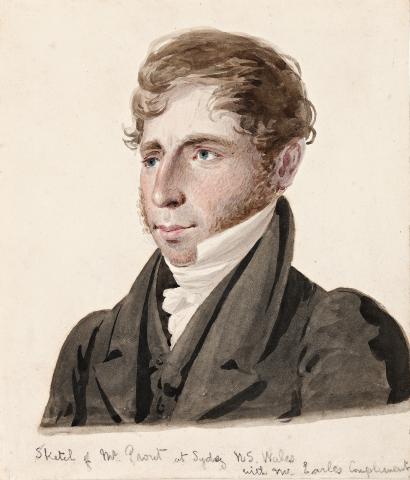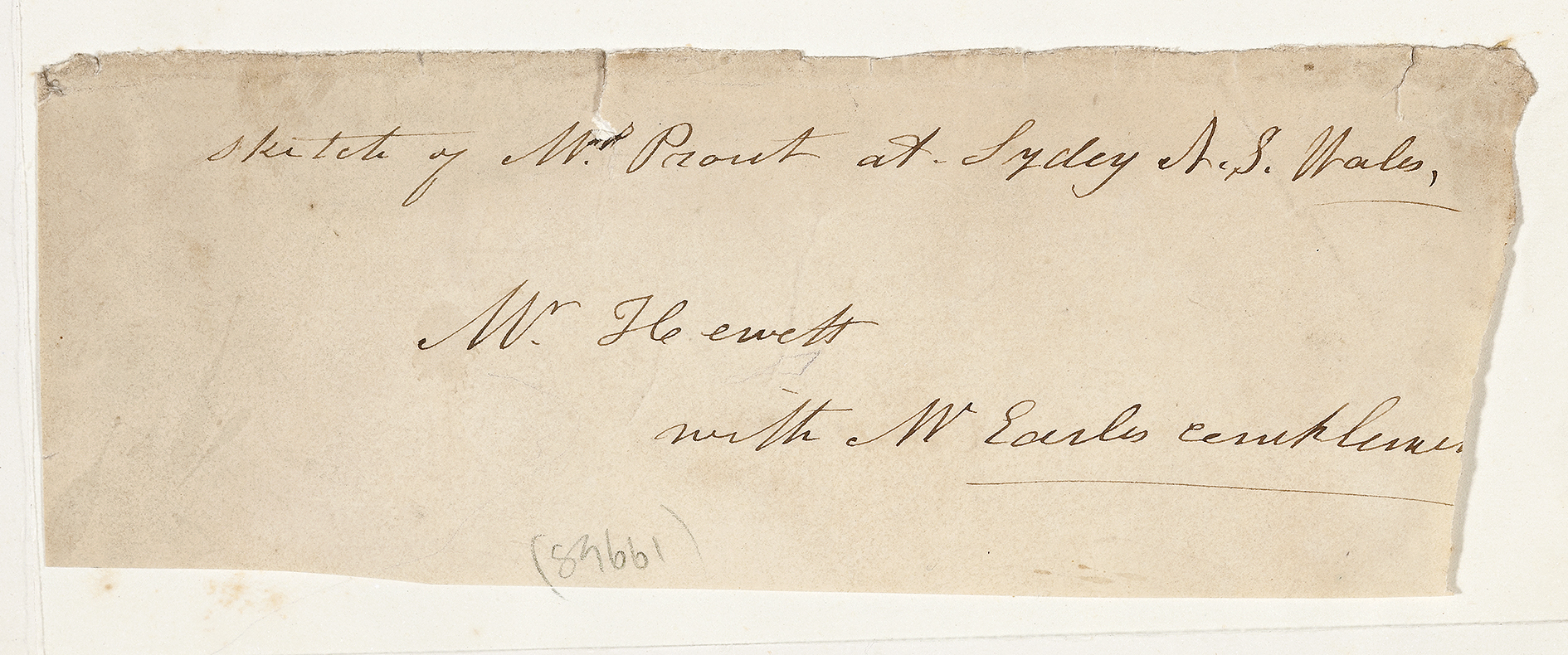SKETCH OF MR PROUT AT SYDNEY, N. S. WALES, c.1828
AUGUSTUS EARLE
watercolour on paper
17.0 x 14.5 cm
inscribed on label attached verso: Sketch of Mr Prout at Sydey [sic] N.S. Wales, / Mr Hewett / with Mr Earles compliments
bears inscription: Sketch of Mr Prout at Sydey [sic] NS. Wales / with Mr Earles compliments
John Hewett, Leamington Spa, England
Sarah Hewett, Leamington Spa, England
Company collection, London
Private collection, Melbourne
From a late 19th century ‘Scrap Album’ of miscellaneous 19th century watercolours and drawings, inscribed on the frontispiece ‘Sarah Hewett’. Included work by Charles Cattermole, Octavius Oakley, William Hunt, William Page and Thomas Baker of Leamington.
Among the cavalcade of characters who visited Australia in the early colonial years, one of the most colourful was Augustus Earle. A gifted artist-adventurer, he spent eight months marooned on the mid-Atlantic island of Tristan da Cunha before eventfully arriving at Hobart Town in January 1825. In Australia, he travelled and sketched widely, visited New Zealand, and later joined the HMS Beagle with Charles Darwin before ill health saw his replacement by another noted colonial artist, Conrad Martens.
Earle was one of the most precociously individual artists of his time. He was probably the first to introduce the subject of bushrangers into Australian art, and admired the nobility of the indigenous people, being sympathetic to their plight. 1 One of his classic works is the oil painting Bungaree, A Native of New South Wales. Fort, Sydney Harbour in the Background, c.1826, (National Library of Australia, Canberra), a portrait of the chief of the Broken Bay tribe dressed in a British general’s uniform and doffing his cocked hat to welcome the strangers to his land. Here and elsewhere, Earle heralded that egalitarianism and laconic sense of humour that would later be considered characteristically ‘Australian’. His keen eye for natural curiosities and individuality of character may be readily seen in his numerous watercolours of the antipodean landscape and many portraits of the notables of Van Diemen’s Land and Sydney. The engaging presentation of a strong sense of character, preference for the half-length pose with sitters facing to their right, and a slight asymmetry of face are among the hallmarks of his portraiture and reveal that undercurrent of caricature so essential to the effective presentation of the personality of the sitter, made infamous many years later by William Dobell and his Archibald winning portrait of Joshua Smith.
Regarded as the leading artist of the Colony, his first major portrait commission in Sydney in 1825 was the highly successful full-length painting of the then departing Governor of New South Wales, Sir Thomas Brisbane. The portrait, now in the collection of the Mitchell Library, State Library of New South Wales, Sydney won much praise from his contemporaries and lead to further commissions from the Colony’s leading families. They included Captain John Piper; Mrs John Piper and her children; John Mackaness, Sheriff of New South Wales in 1826; and the naturalist Dr Robert Townson. Today, the portrait of Piper resides in the Mitchell Library, State Library of New South Wales, and a shoulder-length portrait of Piper is in the National Gallery of Australia, Canberra. The National Gallery of Victoria in Melbourne also has an interesting group of Earle’s portraits of Captain and Mrs Richard Brooks 1826-27, and Captain Thomas Valentine Bloomfield c.1827. Clearly, Earle’s talent as a portrait painter was inherited from two prominent Tory American colonial portrait painters, his father James Earl and his uncle, Ralph Earl.
The portrait on offer here bears additional interest in that it presents Cornelius Prout (born 1793), brother of the artist John Skinner Prout and nephew of the English watercolourist Samuel Prout. Cornelius was purser on HMS Warspite when it arrived in Sydney on 19 October 1826. In January 1827 he gained a discharge, and two years later he was appointed the Colony’s Under-Sherriff. While Earle and Prout’s presence in Sydney overlapped twice, between October 1826 and October 1827, and again in May and October of 1828, the likely date of the portrait is 1828.2 Earle later gave it to John Hewett, the English book, print and watercolour dealer with strong links to the Prout family.
1. Skirmish, Bush Rangers & Constables, Illawarra, 1827, watercolour; and Desmond, A New South Wales Chief, c.1825-7, Nan Kivell Collection (NK12/49) and (NK12/61) respectively, National Library of Australia, Canberra. See also the portrait oil painting, Bungaree, A Native of New South Wales. Fort, Sydney Harbour in the Background, c.1826, (NK118).
2. On 28 and 30 July 1829 The Sydney Gazette published a long letter from the Reverend John McGarvie describing an earlier visit to Earle’s gallery in Sydney. It provided a lengthy but not exhaustive list of the works of art on view, including many portraits. No mention was made of Cornelius Prout.
DAVID THOMAS

